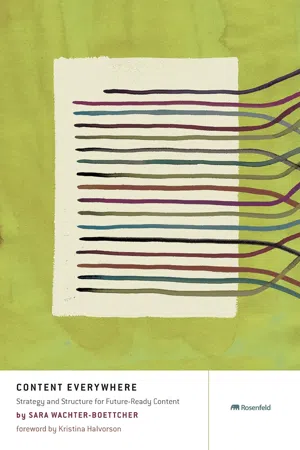
eBook - ePub
Content Everywhere
Strategy and Structure For Future-Ready Content
- 240 pages
- English
- ePUB (mobile friendly)
- Available on iOS & Android
eBook - ePub
About this book
Care about content? Better copy isn't enough. As devices and channels multiply—and as users expect to relate, share, and shift information quickly—we need content that can go more places, more easily. Content Everywhere will help you stop creating fixed, single-purpose content and start making it more future-ready, flexible, reusable, manageable, and meaningful wherever it needs to go.
Frequently asked questions
Yes, you can cancel anytime from the Subscription tab in your account settings on the Perlego website. Your subscription will stay active until the end of your current billing period. Learn how to cancel your subscription.
No, books cannot be downloaded as external files, such as PDFs, for use outside of Perlego. However, you can download books within the Perlego app for offline reading on mobile or tablet. Learn more here.
Perlego offers two plans: Essential and Complete
- Essential is ideal for learners and professionals who enjoy exploring a wide range of subjects. Access the Essential Library with 800,000+ trusted titles and best-sellers across business, personal growth, and the humanities. Includes unlimited reading time and Standard Read Aloud voice.
- Complete: Perfect for advanced learners and researchers needing full, unrestricted access. Unlock 1.4M+ books across hundreds of subjects, including academic and specialized titles. The Complete Plan also includes advanced features like Premium Read Aloud and Research Assistant.
We are an online textbook subscription service, where you can get access to an entire online library for less than the price of a single book per month. With over 1 million books across 1000+ topics, we’ve got you covered! Learn more here.
Look out for the read-aloud symbol on your next book to see if you can listen to it. The read-aloud tool reads text aloud for you, highlighting the text as it is being read. You can pause it, speed it up and slow it down. Learn more here.
Yes! You can use the Perlego app on both iOS or Android devices to read anytime, anywhere — even offline. Perfect for commutes or when you’re on the go.
Please note we cannot support devices running on iOS 13 and Android 7 or earlier. Learn more about using the app.
Please note we cannot support devices running on iOS 13 and Android 7 or earlier. Learn more about using the app.
Yes, you can access Content Everywhere by Sara Wachter-Boettcher in PDF and/or ePUB format, as well as other popular books in Computer Science & Content Management Systems. We have over one million books available in our catalogue for you to explore.
Information
PART I
The Case for Content Everywhere
Too often, today’s content is fixed: stuck to individual pages or in device-specific applications. But as connected devices get more varied, robust, and ubiquitous—and as users expect to find, relate, and share content in more and more ways—we need content that can go anywhere, its meaning and message intact. So how do we stop making more content for every new device or channel and start doing more with the content we make? The answer starts with structuring our content for a future that’s unfixed, fluid, and ever changing.

CHAPTER 1

Framing the New Content Challenge
More Content, More Work | 5 |
Making Content Work Harder | 5 |
Getting Unstuck | 6 |
Thinking Beyond the Page | 8 |
Connecting the Dots | 10 |
Thinking Beyond the Website | 11 |
Learning from Web Standards | 12 |
You Can Start Today | 14 |
Sarah Krznarich loves content.
As the assistant director of content strategy and student engagement for Arizona State University’s Online campus from 2010 to 2012, her job revolved around keeping content fresh, smart, and useful.
When she joined the university, her job was pretty straightforward: She produced orientation content for students getting used to the ASU Online system. But those priorities shifted quickly when the school embarked on a website redesign in late 2010—a redesign that focused on publishing a wide range of content, as shown in Figure 1.1.
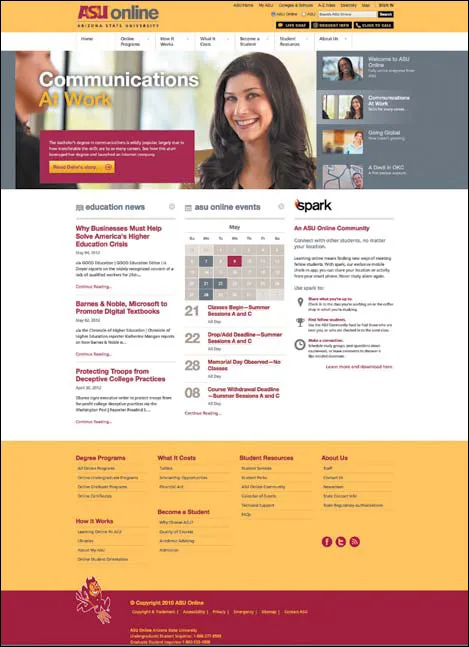
FIGURE 1.1
The redesigned homepage for ASU Online.
The redesigned homepage for ASU Online.
Eager to take ownership of the new site, Krznarich, a former magazine editor, listened intently as ASU Online’s agency, Happy Cog, extolled the virtues of content strategy: the practice of understanding what content is needed to meet both users’ needs and organizational goals, producing it, and creating realistic publishing and governance plans to keep it that way. She picked up Content Strategy for the Web by Kristina Halvorson. She read Ginny Redish’s Letting Go of the Words: Writing Web Content That Works.
Armed with knowledge and backed by her passion for content, Krznarich jumped into action. She refined the ASU Online voice. She launched recurring features profiling current students. She started curating relevant news from outside sources. She pulled program descriptions from the main campus’s assets and revised them for the Online campus’s audience.
Krznarich was getting busy, and not in the recreational way. But the content was good, and the analytics were even better: In the first quarter after the site launched, information requests were up nearly 57 percent over the same period the prior year—and those visitors requesting information were doing so nearly a minute faster than before.
Total win, right?
More Content, More Work
Yet Krznarich, now an independent content strategist, didn’t quite see it that way. Whenever she wanted to update ASU Online’s calendar, she had to find, copy, and paste relevant events from the main site. When a program was updated at ASU’s main campus, she had to make a manual update on the Online site. Plus, there was the website for current ASU Online students, which featured similar, but more detailed, content as the site for prospects. When one required an update, the other was likely to need a refresh, too. And that was just the start.
It felt like the more content Krznarich made, the more she was asked to make content—and the less time she had to make it any good. But her content needs—and the time and resources it took to meet them? They kept on multiplying.
Making Content Work Harder
Whether you’ve managed a website yourself or worked to architect, design, or build one, this plight may be familiar: content needs that grow and grow, siloed information that requires repetitive updates, and those who are responsible for it all left barely able to keep up.
Like ASU Online, maybe you’ve embraced the discipline of content strategy as a means to plan for and produce better content—content that’s not just up-to-date, compelling, and meaningful, but also serves a purpose beyond filling space on a page. But investing in strategic, quality content takes time, skills, and money. Managing it takes even more. Even if you can allocate appropriate resources now, those resources will quickly be spread thin as devices and channels—and your need for quality content to serve them—continue to multiply.
What if there were a better way?
Instead of creating new content for every platform, channel, and device, what if people like Krznarich could put their valuable time and budget into better, more meaningful content assets, and do more with each one? What if there were a system for organizing and architecting content—one that actually made it easier for our organizations and clients to achieve a number of goals:
- Reuse content in multiple places and for multiple purposes.
- Make content more relevant and appropriate for users.
- Improve the experience of finding, using, sharing, and saving content across devices and channels.
- Spend less time managing content updates and maintenance.
- Still keep their message and editorial vision intact.
Turns out, there is. But it will take more than style guides and editorial calendars to get there.
If you want content that’s ready for whatever the future holds, it’s time to stop making more content, and instead start building systems that allow you to do more.
That’s the mindset this book will help you embrace.
Getting Unstuck
Let’s start where our online content currently stops: namely, on the fixed webpages where most of it resides, unable to travel beyond the bounds of a single rendering—resulting in the broken experiences you see in Figure 1.2. Formatted through a content management system’s WYSIWYG (what-you-see-is-what-you-get, or whizzy-wig) editor, most content today is designed to be displayed in just one way: on a desktop monitor. When viewed on devices with different screen sizes or capabilities, it quickly loses its hierarchy, priority, and organization.
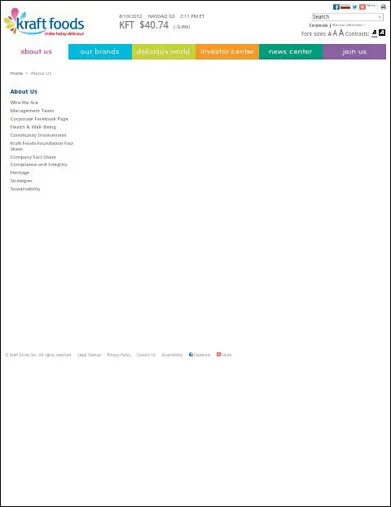
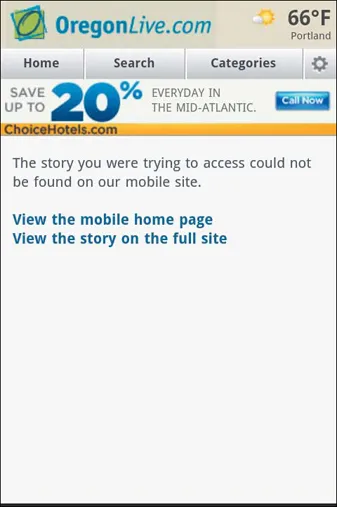
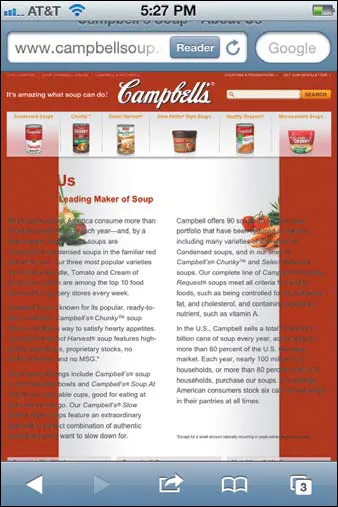
FIGURE 1.2
Broken, blob-like, inaccessible, or just plain ugly—is this what we had in mind as our content goes mobile?
Broken, blob-like, inaccessible, or just plain ugly—is this what we had in mind as our content goes mobile?
Stripped from its format, content’s meaning breaks down. Photos and captions that together tell a story become unrelated images and copy. Subheads become text snippets. Pull quotes become just another sentence in the endless flow of information. Systems to relate and link one piece of content with another are limited to manual tagging—time-intensive and prone to error—or traditional navigation systems, which tend to limit relationships to hierarchies.
In short, when we publish content while thinking solely about “pages,” we end up with content that’s fixed firmly to its place—far from the flexible and future-ready information we need.
Don’t we want more for our content than this?
Thinking Beyond the Page
I learned firsthand how limiting big, fixed pages of content could be while working on Arizona Office of Tourism’s large state-run tourism website, arizonaguide.com. In 2009, as a newly minted content strategist working on a major overhaul of the site, I spent months auditing content, creating style and message guides, and editing key pages. I planned ahead, collaborated with the client’s content creators and managers, and fought to have real content used in our designs. In short, I was living the content strategist’s dream: plenty of messy content to work with, and clients who wanted me to make it better.
Only things didn’t go quite as planned.
While I toiled away on Excel spreadsheets and governance guides, the rest of the team designed new features and built out templates. But at launch, a major problem emerged. Thousands of pieces of content about landmarks, businesses, and destinations existed in multiple unrelated legacy databases, each organized and labeled differently, making it impossible to create the relationships and context to transform them from disconnected data points into relevant content findable when and where it made sense.
Take the city of Sedona, shown in Figure 1.3. Famous for its stunning red rocks and artists’ enclaves, it’s chock-full of things to do, many of them the sort of once-in-a-lifetime activities travel magazines rave about: gorgeous hikes, posh spas, five-star golf resorts, even “energy vortices,” if you’re into that whole New Age thing.

FIGURE 1.3
Picture-perfect Sedona. Who wouldn’t want to vacation here?
Picture-perfect Sedona. Who wouldn’t want to vacation here?
You wouldn’t have known any of that information by looking at the city’s page on the then-new website, a comp of which is shown in Figure 1.4. Featuring little but some canned copy and a link to Sedona’s visitors’ bureau, the page barely hinted at the plethora of things to do there. Perhaps worse, the content in the sidebar—including events, travel deals, and articles—was randomly selected on page load, not tied to Sedona at all.

FIGURE 1.4
Sedona’s page on the arizonaguide.com website. Where’d all the magic go?
Sedona’s page on the arizonaguide.com website. Where’d all the magic go?
Want to visit Sedona? No problem. Want to learn about road biking tours? Easy. Want to see if anyone offers road biking tours near Sedona? Good luck.
The dots were all there, but there was no way to connect them. Between page-level content that lacked meaningful elements and outdated databases whose attributes were inconsistent or simply ignored, the site was missing a way to relate information across these disparate sections...even though that’s exactly what our users wanted.
Connecting the Dots
Thankfully, that’s not where this story ends. It’s actually where my own lean toward more flexible content begins, because I realized how little we could do with this high-quality but totally unstructured content.
A couple years later, I had the opportunity to begin solving the problem—and, more importantly, to help the Arizona Office of Tourism (AOT) staff understand that disconnected, fixed data was limiting their ability to create the experience they wanted, both for users with desktop computers and those on mobile devices.
As you’ll see in detail later in this book, I did this by going back to those legacy databases, taking pages of content and identifying the salient pieces of information they’re made of, then breaking those pages into content chunks to match. This allowed us to supplement our hierarchical site structure—that is, a standard navigation full of submenus—with a system based on shared content attributes, like the cities in which attractions were located, and logical rules that dictated how and when cont...
Table of contents
- Cover Page
- Title Page
- Copyright Page
- DEDICATION
- HOW TO USE THIS BOOK
- FREQUENTLY ASKED QUESTIONS
- CONTENTS
- FOREWORD
- INTRODUCTION
- PART I The Case for Content Everywhere
- PART II The Elements of Content
- PART III Putting Structured Content to Work
- PART IV Enduring Content
- Index
- ACKNOWLEDGMENTS
- ABOUT THE AUTHOR
- Footnotes